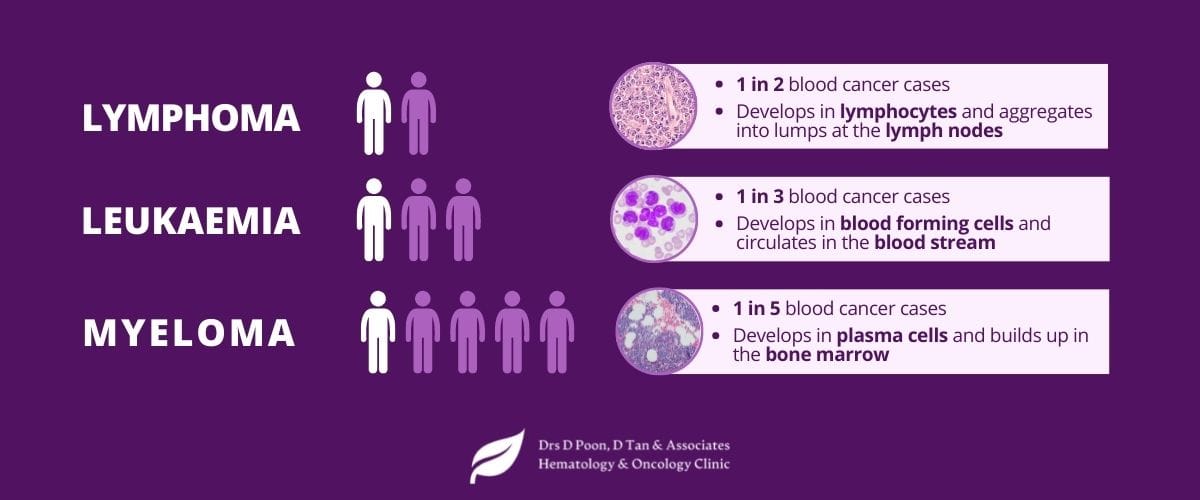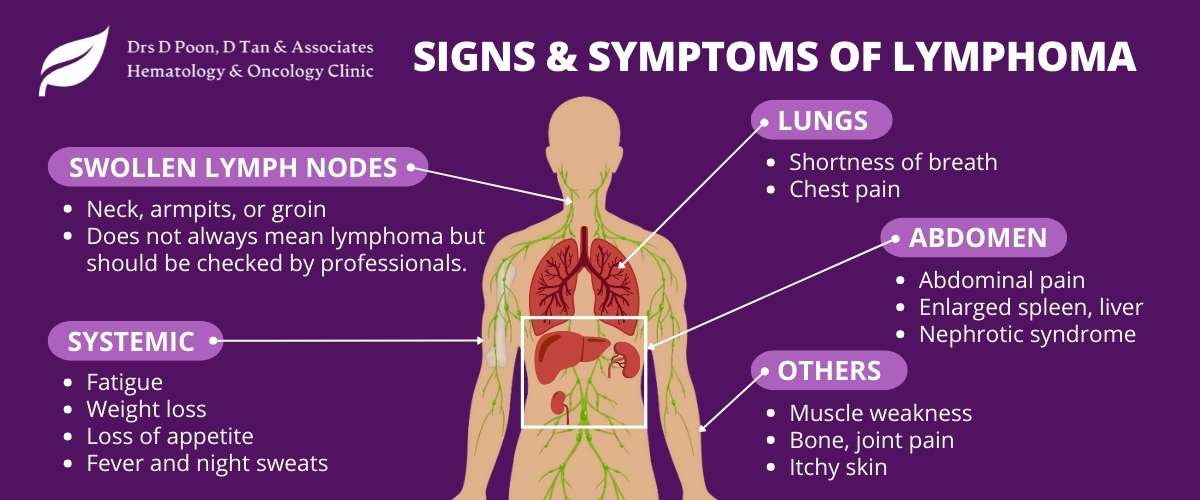
A Bump In The Neck – When Should You Be Worried About Lymphoma
Table of Contents
- What is lymphoma?
- Causes of lymphoma
- Risk factors of lymphoma
- Types of lymphoma
- Lymphoma vs Leukaemia vs Myeloma
- Signs and symptoms of lymphoma
- Diagnosis of lymphoma
- Staging lymphoma
- Treatment of lymphoma
- Different treatment of lymphoma
- Prognosis of lymphoma
- Prevention of lymphoma
- Takeaway Message
Lymphoma is a type of blood cancer affecting the lymphatic system. Together with the other 2 main types of blood cancer – leukemia and myeloma, this group of cancer makes up the 5th and 6th most common cancer among men and women in Singapore respectively.
As the lymph system is present all over the body, lymphoma can develop from any location and spread quickly. This article aims to provide you with the essential knowledge about this cancer, including how it is different from other types of blood cancer, how to recognise its symptoms early, its causes and risk factors, diagnosis, treatment, and preventive measures.
What is lymphoma?
To understand lymphoma, it is important to get ourselves familiarised with the lymphatic system where lymphoma tumours develop.
The lymphatic system is a part of our immune system. It consists of approximately 500-600 lymph nodes connected by a network of vessels that move a fluid called lymph through your body. This system produces, stores and deploys a type of white blood cells called lymphocytes. Upon detecting threats such as foreign invasion from bacteria and viruses or abnormal behaviours from cancerous cells, they quickly multiply and release antibodies to protect the body.
Despite their protective role, the lymphocytes can go rogue themselves and become cancerous under certain circumstances. This is known as lymphoma, or lymphatic cancer. Although it occurs more frequently in older adults, children can also develop this cancer.
Causes of lymphoma
Like all types of cancer, lymphoma occurs when lymphocytes lose their proliferation brakes, often as a result of a genetic mutation occurring in the DNA of these cells. Typically, lymphocytes have a brief life span. They die quickly after completing their mission. In the case of lymphoma, however, this feature does not work properly. Cancerous lymphocyte cells do not fight diseases but multiply quickly. Tumour forms as these cells thrive for longer than they should and invade other cells.
So far, we still don’t know exactly what triggers the DNA changes leading to lymphoma. However, a number of risk factors have been identified. Keep in mind that even people without any risk factors may develop lymphoma.
Risk factors of lymphoma
Hodgkin’s lymphoma and non-Hodgkin lymphoma have their own risk factors. As such, we will look at the risk factors of each type below.
Risk factors of non-Hodgkin lymphoma
- Age – The vast majority of these cases occur in people older than 60 years.
- Gender – Being a male increases your risk of certain types of non-Hodgkin lymphoma.
- Ethnicity and location – People of Asian descent have a slightly lower risk of this cancer compared to Caucasians. Moreover, this tumour occurs more in developed countries.
- Chemicals and radiation – Like all cancers, getting exposed to certain chemicals and radiation may elevate your risk of non-Hodgkin lymphoma.
- Immunodeficiency – Individuals with impotent immune systems are more likely to develop lymphomas. This could be due to HIV or immunosuppressive drugs given after an organ graft.
- Autoimmune diseases – Autoimmune diseases such as rheumatoid arthritis, Sjogren’s disease, systemic lupus erythematosus (SLE), celiac disease are a risk factor for lymphomas.
- Vital infections – Getting the Epstein-Barr virus (EBV) is linked to a higher incidence of non-Hodgkin lymphoma.
- Breast implants – For this specific risk factor, large cell lymphoma of the breast may occur.
- Bodyweight and diet – The ACS suggests that obesity and poor dietary choices may be underlying causes of lymphomas. With that said, there is little evidence to support or deny these claims.
Risk factors of Hodgkin’s lymphoma
- Infectious mononucleosis – EBV causes an infection known as mononucleosis. This virus increases the risk of both types of lymphoma.
- Age – There are two age groups when Hodgkin’s lymphoma is most prevalent – 20 to 30 years old, and people over the age of 55.
- Gender – Hodgkin lymphoma is slightly more prevalent in men compared to women.
- Family history – Having a relative with Hodgkin’s lymphoma makes you prone to developing this disease. The closer the relative is, the higher your risk. For instance, if you have an identical twin sibling, your risk is more significant.
- HIV infection – A weakened immune system predisposes you to several types of cancer, including this one.
Types of lymphoma
Primarily, there are two main types of lymphoma – Hodgkin’s lymphoma and non-Hodgkin lymphoma (NHL). They were named after the renowned pathologist who first identified lymphoma in 1832 – Dr Thomas Hodgkin. The hallmark of Hodgkin’s lymphoma is the presence of a type of cancer cells called Hodgkin and Reed-Sternberg (HRS) cells. Non-Hodgkin lymphoma does not contain these cells. It is important to determine the type of lymphoma, as treatment varies for different types.
Globally and locally in Singapore, non-Hodgkin lymphoma is relatively more common than Hodgkin’s lymphoma. Digging deeper into the specific types of lymphomas, there are various subtypes, totaling more than 70. We will look at some of the main subtypes for each major type of lymphoma below.
Types of Non-Hodgkin lymphoma
Depending on the type of lymphocyte cells affected, we have the following common subtypes:
B-cell lymphoma
This type is one of the most common Non-Hodgkin lymphoma. It arises from abnormal B cells – the type of lymphocyte cells responsible for creating antibodies to fight viruses or bacteria.
- Diffuse large B-cell lymphoma (DLBCL) is a common and aggressive subtype, accounting for 1 in 3 cases of B-cell lymphoma. With appropriate therapy, the prognosis of this tumour is often positive. However, untreated DLBCL can rapidly lead to death.
- Follicular lymphoma: Around 20% of lymphomas are follicular lymphoma. This type is more common in older individuals, especially those over the age of 60. Due to the slow-growing pace of this cancer, treatment is usually effective.
- Burkitt’s lymphoma: This type of B-cell NHL is highly aggressive. It is most common in children and immunocompromised individuals.
T-cell lymphoma
As the name implies, these tumours stem from T-cells – the lymphocyte cells that help the body recover from diseases by getting rid of infected cells. Only 15% of non-Hodgkin lymphoma are T-cell lymphoma.
Types of Hodgkin’s lymphoma
Pathologists look for the characteristics of the Hodgkin and Reed-Sternberg (HRS) cells to classify Hodgkin’s lymphoma into the following subtypes:
Lymphocyte-depleted Hodgkin’s disease
Representing 1% of all lymphomas, this type is quite rare and aggressive. The most common age group affected by this tumour are people in their 30s. The primary trigger of this tumour is immunosuppression. For this reason, individuals with HIV and those receiving immunosuppressive drugs are more likely to develop this type of lymphoma.
Lymphocyte-rich Hodgkin’s disease
This type of lymphoma is characterised by the abundance of RS cells and lymphocytes. It accounts for 5% of Hodgkin’s lymphoma cases and affects men more than women.
Mixed cellularity Hodgkin’s lymphoma
This is a more common type of Hodgkin’s lymphoma. Almost 25% of all cases are mixed cellularity. We see this cancer more in older adult men.
Lymphoma vs Leukaemia vs Myeloma
Lymphoma, leukaemia and myeloma make up the 3 major types of blood cancer. They differ in the type of cells they affect, their locations and how they are diagnosed and treated.
- Lymphoma is the most common among the three types, estimatedly affecting 1 in 2 people diagnosed with blood cancer. It is more common in older adults. Lymphoma originates from a type of white blood cells called lymphocytes, which often aggregates into lumps at the lymph node areas. Diagnosis therefore involves biopsy of the tumour.
- Leukaemia is less common than lymphoma, with approximately 1 in 3 blood cancer cases diagnosed as leukaemia. It is more common in children. In fact, it is known as one of the childhood cancers. Leukaemia develops in the blood forming cells in the bone marrow but circulates in the bloodstream. Blood tests can typically reveal leukaemia, after which bone marrow biopsy is often ordered to confirm a diagnosis and determine the type of leukaemia.
- Myeloma, most commonly multiple myeloma, is the least common type of blood cancer among the three. It stems from a type of white blood cell called plasma cells which produce antibodies and lymphocytes to protect us from infections. These malignant plasma cells often build up in the bone marrow, causing damages to the bones. Unlike leukaemia, myeloma often does not circulate in the blood. The disease affects about 1 in 5 blood cancer patients.

Signs and symptoms of lymphoma
During the early stages, lymphoma may not present with any specific symptoms. Even when the symptoms of lymphoma start to appear, their nonspecific nature is a key reason for delayed diagnosis.
The most obvious symptom is often swelling of the lymph nodes in the neck, under the arm or other regions such as upper chest, stomach, cervical or groin region. They may or may not be painful. They may go away for a while then return.
Note that most people who experience this symptom do not have lymphoma. For instance, a strep throat may cause the lymph node near the throat to swell. However, if you notice a bump in the neck or a swollen lymph node elsewhere without signs of infection, it is a good idea to have it thoroughly checked by a doctor. Early diagnosis often improves treatment outcome and prognosis.
Aside from the swelling of the lymph node, other signs and symptoms of lymphomas include:
- Persistent fever and chills
- Persistent night sweats
- Unexplained weight loss
- Unexplained cough
- Fatigue
- Itchy rashes
- Loss of appetite
- Shortness of breath
- Stomach pain
- Enlarged spleen
The presence of other symptoms in addition to the swollen lymph node often indicates serious cases. Do not delay your visit to the doctor in these cases.

Diagnosis of lymphoma
If your doctor suspects a malignant process, he/she will most likely do a biopsy to confirm or exclude the diagnosis. The doctor will remove one of the lymphoma nodes and send it to a histopathologist for microscopic examination. This is the gold standard way of diagnosing lymphomas and other types of cancer.
If the diagnosis of lymphoma is confirmed, a series of tests will be ordered to objectify the spread of the tumour, stage the lymphoma and determine treatment plan.
Some of these tests include:
- Complete blood count (CBC) to check the number of white and red blood cells
- Chest X-rays
- Bone marrow aspiration
- Lumbar puncture
- Abdominal ultrasound
- Testing nearby lymph nodes
- CT scans and MRIs: These are often the most effective tests to identify the expansion of the cancer.
Staging lymphoma
There are four stages of lymphoma, whether it’s Hodgkin’s or non-Hodgkin’s lymphoma. The prognosis and treatment plan of lymphoma are highly dependent on this staging.
- Stage 1 – Cancer is confined to one lymph node or one organ
- Stage 2 – Cancer affects two lymph nodes near each other and on the same side of the body. Alternatively, cancer affects one organ and a nearby lymph node.
- Stage 3 – Cancer affects lymph nodes on both sides of the body.
- Stage 4 – Cancer affects an organ and distant lymph nodes. Common locations for metastasis include the liver, bone marrow, and lungs.
You may hear your doctor also grade non-Hodgkin’s lymphomas based on their rate of growth. For this purpose, these terms are used:
- Low grade or indolent
- Intermediate grade or aggressive
- High grade or highly aggressive
Treatment of lymphoma
Lymphoma is often treated by a team of healthcare professionals. We call this a multidisciplinary approach. You may or may not meet all of them. Specialists from these fields will gather to decide the treatment modalities:
- Haematologists who specialise in immune disorders, blood, and bone marrow
- Oncologists who treat cancers
- Pathologists to identify the type of lymphoma and assist with treatment planning
Depending on the type of lymphoma, the staging of the cancer, your age, overall health and treatment objective, the doctors will recommend a treatment plan. Note that low-grade or indolent tumours may not require any treatment. Instead, your doctors will suggest monitoring to make sure the tumour does not spread or take action if it does.
Different treatment of lymphoma
Once your team of doctors reaches a consensus, one or more of these treatments may be necessary:
Biologic therapy – These drugs stimulate immune cells to become more efficient at identifying and neutralising cancer cells. Achieving this goal requires the introduction of living microorganisms to the body. A treatment called CAR – T cell is currently used to treat lymphoma containing a B-cell antigen B19. CARs are molecules that identify and neutralise cells that contain specific proteins on the surface of lymphoma cells. The ‘T-cell’ part of this therapy refers to removing T cells from patients and modifying them genetically to produce CARs. Once these cells reach the billions, they get infused back into the patients to destroy the lymphomas. Learn more about how immunotherapy works in cancer treatment in our guide to immunotherapy.
Antibody therapy – The job of these antibodies is to respond to the toxins released by cancer cells. This is a type of immunotherapy because it stimulates the body’s own defence to fight cancer. You need to meet several criteria to be a candidate for this treatment.
Chemotherapy – This is a classic cancer treatment and remains one of the most common treatments for lymphoma. Anticancer drugs are injected or taken orally to kill rapidly-growing cells in the body, including cancer cells. The doctor may prescribe you more than 1 type of drug.
Radiation therapy – Early stage localised lymphoma may benefit from radiation therapy. This treatment can also be used with chemotherapy for enhanced effectiveness or for palliative purposes to relieve pain.
Radioimmunotherapy (RIT) – By combining radiotherapy and immunotherapy, this treatment can deliver radioactive doses directly to the cancerous cells. RIT is currently used to treat non-Hodgkin B-cell lymphoma.
Stem cell transplantation – This is especially beneficial to restore damaged bone marrow after a high dose of radiation therapy or chemotherapy.
Surgery – Removing the spleen or other affected organs can help with stopping the spread of lymphoma.
During treatment, it is important to protect yourself from common infections, as your immune system is compromised. Maintaining good hand hygiene, using a face mask, eating thoroughly cooked food, and drinking lots of fluids are useful ways to keep flu, food poisoning and urinary tract infection at bay. Check with your doctor for more specific instructions.
Each of these treatments has its unique indications and contraindications. Therefore, do not hesitate to ask your doctor to explain the ins and outs of each therapeutic modality and how it is helpful to your specific case. Ultimately, understanding your condition, discussing with your primary care physician, haematologist, and oncologist can help you and the doctors decide what’s best for you.
Prognosis of lymphoma
The prognosis of lymphoma depends mainly on its staging. The ACS states that the 5-year survival rate for stage 1 Hodgkin’s lymphoma is around 91%. This percentage drops slightly for stage 4 patients to reach up to 81%. For non-Hodgkin’s lymphoma, however, the survival rates are much lower. They range from 57% to 73% depending on the type of tumour and its staging.
The good news is that many types of lymphoma are curable. Additionally, some types grow slowly, allowing the patients and doctors to take their time with treatment. In fact, some tumours have such a slow growth that doctors decide not to treat them at all. The reasoning behind this decision is that the prognosis remains the same with or without treatment.
Prevention of lymphoma
We currently do not possess any definitive way to prevent lymphomas. Despite identifying the risk factors, these cancers just keep occurring. What you can do about lymphoma prevention is to avoid catching certain infections such as HIV and EBV. Because HIV leads to AIDS, the risk of lymphoma becomes significantly higher.
Another virus to keep in mind is the human T-cell lymphotropic virus (HTLV-1), which is particularly impactful on non-Hodgkin lymphoma. The Caribbean region and Japan are hotspots for the spread of this virus.
Takeaway Message
Most of us experience a bump at the lymph node at some point. Most of the time, it just means our body is working hard to protect us from an infection or a disease. But some other times, it is a sign of something more serious – lymphoma. The only way to know for sure is to take notice of the swollen lymph node yourself and have it checked by a doctor early on.
We hope that this article helps you appreciate the diverse nature of lymphoma, how it can be detected, diagnosed and treated. Do not hesitate to contact your doctor if you or your loved one have a growing lump in the neck. Learning how to identify these tumours at an early stage is vital to improve your outcome.




